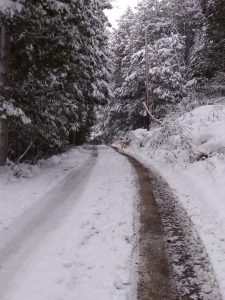 It’s the journey, not the destination—I keep reminding myself. And it’s a long journey, or at least I’m making it one. It was about a year ago that I decided to re-write the novel that I’d already written seven times. I was going back to scratch. I’d hoped it would take me three months, but now I’m hoping I’ll be done before the end of this year.
It’s the journey, not the destination—I keep reminding myself. And it’s a long journey, or at least I’m making it one. It was about a year ago that I decided to re-write the novel that I’d already written seven times. I was going back to scratch. I’d hoped it would take me three months, but now I’m hoping I’ll be done before the end of this year.
In that year, I got wrapped up in a bit too much volunteer work, over-extending myself. Of course, the writing got squeezed, but I still wrote something almost every day, just not always my novel. That’s been sporadic, at best. (I’ve been using Pacemaker so I now have a visual graph of my bad writing habits.)
I always keep learning, keep taking more in. The more I learn about writing, the more I wonder what I thought I knew before. And does the learning ever end? (I think not!) At a friend’s suggestion, I ordered a copy of Robert McKee’s, Story. I also ordered John Truby Presents, The Anatomy of a Story—22 steps to becoming a Master Storyteller. Another excellent read.
There are many guides along the journey: our writing friends, workshops, festivals and more writing books. (What writer doesn’t love reading?) I attended two great festivals this year: The Alice Munro Festival of the Short Story and Words Aloud, the Spoken Word and Storytelling Festival. Both were so inspiring, to hear from such masters of words, and to learn from them in the workshops offered.
It was my substantive edit that spurred me on to this major re-write—I had to re-work the plot entirely. My main character was too passive. I couldn’t see any other way, other than re-writing it, making her the force driving the novel. And I’m 2/3 the way through and starting to wane. I knew I had keep the conflict and tension going, but wasn’t sure how. Last year, I bought several books on conflict and tension.
And I went back to some online courses I had taken. As I was doing this re-write, another writing friend had shared a course by two UBC professors, Nancy Lee and Annabel Lyon. It was a course I could do online and it was just at the right time. How to Write a Novel: Structure and Outline. This helped me to outline my new plot. That course was followed up with, How to Write a Novel: Writing the Draft.
I can still access the videos and course material, popping into whatever section I’m struggling with. There are so many resources to take advantage of, to get us to the next better version of our writing. I wish I was a natural–that every step of the process wasn’t a struggle for me, but that’s not my story.
I was struggling in my novel, with a wedding scene. I wanted it to be nice. After all, it was her best friend’s wedding, of course it should be nice. But wouldn’t that be boring? I was blocked. I needed this scene to happen, needed her to get with the guy and all to have a nice warm fuzzy feeling. How do I create conflict where there isn’t any? And then it hit me, that was my job as a writer, to make conflict—to imagine it. This is the fun of writing! There’s no block, I just have to figure it out.
Now, without all the extra stuff in my life to worry and think about, my mind is open to focus on my novel. When I go for my daily walks, I’m not worried about my to-do list, I’m worried about how to make everything hard for my protagonist. I’m not thinking about how to avoid conflict, but how to create it.
And I’m in the sticky middle, so I have to imagine that much harder. But I have a lot to background to work with. And now it is making some interesting turns, things I didn’t expect but seem more obvious to make the tension and release, satisfying. I’ve come full circle in my writing. I’ve spent so long on craft, I’ve finally back to story.
But now I have to go back to craft! This is first draft writing—clunky, lacking in subtlety and specificity. I have to comb through and make it pretty again. All that work I did before only to find the story needed more work. I was going to go back to my substantive editor, but I was certainly feeling shy with the state of my prose, not sure I should do that after this “first draft”.
And then this course popped up in my feed, the next in the series—starting in January: How to Write a Novel: Edit and Revise. Just what I needed it, just when I needed it.
The books we read, the workshops we take, the friends we make; are all part of the journey and add to the writer’s experience and expertise. And just when we think we’ve done it all, learned it all, we can find ourselves right back where we started, but changed in so many ways. Happy writing and enjoy the journey!